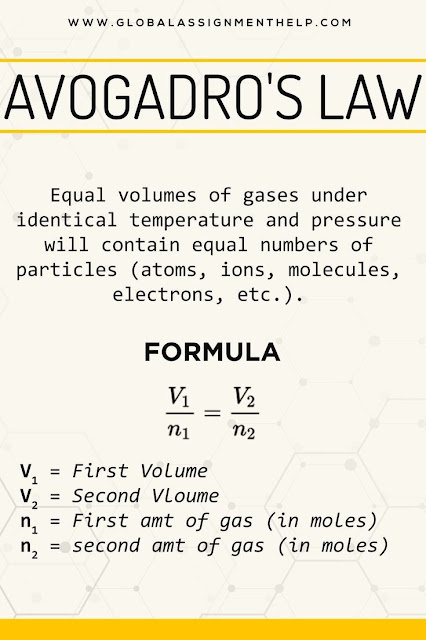Avogadro's Law Explained in Detail
Definition:
Avogadro’s Law is one of the fundamental principles of gas behavior and is part of the ideal gas law. It states that:
At constant temperature and pressure, the volume of a gas is directly proportional to the number of moles (amount) of gas.
This means if you have two gases at the same temperature and pressure, and they occupy the same volume, they will contain the same number of gas particles, regardless of the type of gas.
Key Components of Avogadro's Law:
1. Temperature: It is assumed to remain constant. Changes in temperature affect the energy and movement of gas particles, which in turn can affect volume, but Avogadro's law applies only when temperature is constant.
2. Pressure: Pressure must also remain constant. Changes in pressure, just like temperature, will affect the volume, but Avogadro's law works under constant pressure conditions.
3. Volume (V): The space that the gas occupies is proportional to the number of particles (moles) present. The more gas particles present, the larger the volume the gas will occupy, as long as temperature and pressure are unchanged.
4. Moles (n): This is the amount of substance, and for gases, it is usually measured in moles. One mole of any gas contains the same number of particles, known as Avogadro's number (approximately \(6.022 \times 10^{23}\) particles).
Mathematical Expression:
\frac{V_1}{n_1} = \frac{V_2}{n_2}
This equation means that the ratio of the volume of a gas to the number of moles remains constant if the temperature and pressure are constant.
- \( V_1 \): Initial volume of the gas
- \( n_1 \): Initial number of moles of gas
- \( V_2 \): Final volume of the gas
- \( n_2 \): Final number of moles of gas
How it Works:
- If you increase the amount of gas (n) by adding more moles, the volume \(V\) will also increase to keep the ratio the same.
- If you remove gas molecules (reduce n), the volume \(V\) will decrease proportionally.
Example:
Suppose you have 2 liters of gas containing 1 mole of molecules at a certain temperature and pressure. According to Avogadro’s law:
- If you double the number of moles (to 2 moles), the volume will also double to 4 liters (since the amount of gas is directly proportional to the volume).
- If you cut the amount of gas in half (to 0.5 moles), the volume will reduce to 1 liter.
Applications of Avogadro’s Law:
1. Understanding Molar Volume:
At standard temperature and pressure (STP), one mole of any ideal gas occupies approximately 22.4 liters. This is a direct application of Avogadro’s Law.
2. Gas Mixtures:
In mixtures of gases, each gas behaves as if it occupies the entire volume, so the law helps calculate the proportions of different gases in a mixture.
3. Chemical Reactions Involving Gases:
In reactions where gases are involved, Avogadro’s law allows chemists to predict how much gas will be produced or consumed in a reaction by knowing the volume and number of moles.
4. Respiratory Physiology:
In biology, Avogadro’s law helps explain gas exchange in the lungs. It illustrates how changes in the amount of air affect lung volumes during breathing.
# Conclusion:
Avogadro’s Law is essential in understanding gas behavior and has a wide range of applications in chemistry and physics. It shows the direct relationship between the amount of gas and the volume it occupies, making it a crucial concept in gas dynamics.
